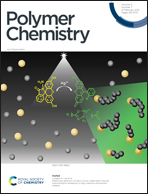Naked-eye detection of Hg(ii) ions by visible light-induced polymerization initiated by a Hg(ii)-selective photoredox catalyst†
Abstract
We developed a novel strategy for signal amplification using a visible light-induced photopolymerization, initiated by a selective turn-on photoredox catalyst. As photoredox catalysts, fluorescein derivatives are able to initiate photopolymerization and rapidly form a polymeric hydrogel in the presence of oxygen under visible light. Moreover, they exhibit selective chromogenic and fluorogenic responses to transition metal ions in the visible region of light. In this work, we employed fluorescein hydrazide as a switchable photoredox catalyst for the generation of a colorimetric readout of Hg(II) ions via the visible light-induced photopolymerization of N-vinylpyrrolidone and poly(ethylene glycol) diacrylate under aerobic conditions. Compared to ultraviolet–visible (UV–Vis) spectroscopy, this photopolymerization-based signal amplification yielded about 20 times higher sensitivity and enabled the naked-eye detection of Hg(II) ions with concentrations down to 0.1 μM.



 Please wait while we load your content...
Please wait while we load your content...